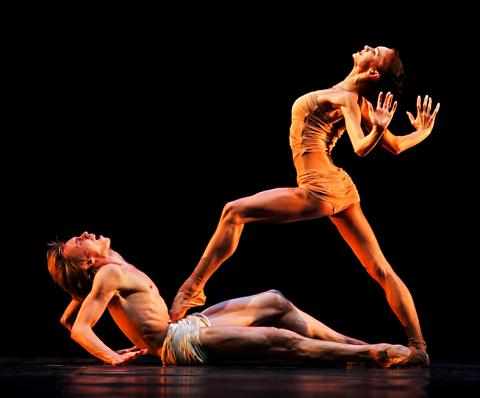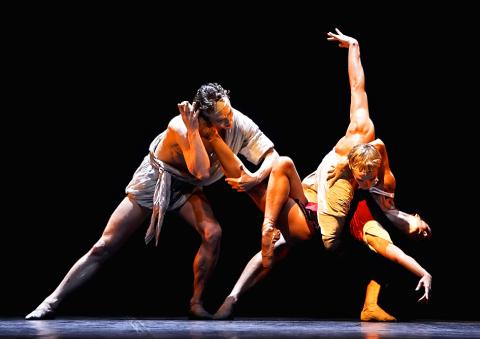The Staatsballett Berlin (Berlin State Ballet) will be taking over the National Theater next week for two Taiwan premieres — its own debut and two performances of its stunning production of Mauro Bigonzetti’s 2008 two-act ballet Caravaggio.
Though it will not be celebrating its 10th anniversary until next year, the Staatsballett Berlin can boast of a long and gloried history. The company was formed in 2004 by the merger, triggered by the city’s financial crisis, of the ballet companies of the German capital’s three opera houses: the Deutsche Oper Berlin, Staatsoper Unter den Linden and Komische Oper Berlin. The company continues to perform on all three stages. The history of ballet in Berlin goes back to 1742, when Fredrich the Great founded the Royal Opera House Unter den Linden and the first ballet company.
Ukraine-born, Bolshoi Ballet-trained Vladimir Malakhov became artistic director and first soloist of the Staatsballett Berlin in 2004, after a stint at the Moscow Classical Ballet, Vienna State Opera Ballet, National Ballet of Canada and American Ballet Theater and guest artist appearances with a number of other companies. His main job was to forge a united identity for the survivors of the disparate troupes, who like most ballet companies worldwide, have dancers from many countries.

Photo Courtesy of Enrico Nawrath
The Staatsballett Berlin is one of the largest companies in Europe, with 88 dancers and two apprentices hailing from about 25 nations. It is a classical ballet company, though its repertoire includes modern works from many of the best choreographers working today.
The 45-year-old Malakhov, who announced earlier this year that he will step down as artistic director next year, will dance the lead in Caravaggio on both Thursday and Friday, as well as perform Maura de Candia’s Dying Swan and another piece at the two gala performances on Saturday (more about the gala in Thursday’s paper).
Bigonzetti, the former artistic director of Italy’s Fondazione Nazionale della Danza Aterballetto (which performed two of his ballets in its appearance at the National Theater in November last year), set his ballet about the 16th century Italian painter on a collection of musical works by a contemporary of Caravaggio, Claudio Monteverdi, adapted by Italian composer Bruno Moretti.

Photo Courtesy of Enrico Nawrath
Caravaggio, born Michelangelo Merisi, was a gifted and rebellious painter, known as much for his paintings as fighting and duels. His brawls forced him to relocate several times between Rome, Naples and Malta before his death at age 39. His use of light — extreme contrasts between light and shadow, brightness and darkness — and realistic approach scandalized contemporary society, but has influenced generations of artists. His life has also been the inspiration for several recent films and dance productions.
Bigonzetti’s production seems to take a biographical approach, with sections titles such as Journey to Rome and Dispute and Duel, but it is probably best to approach it with an open mind and no expectations of being able to identify places, people or images from Caravaggio’s works. From video clips, it appears Bigonzetti’s choreography and staging blend the artist’s life with his imagination until it is difficult to know where one ends and the other begins.
Ballet fans have been looking forward to Malakhov appearance, as well as that of many of the company’s other stars, including Shoko Nakamura, Elisa Carrillo Caabrera, Nadja Saidakova, Iana Salenko and Dinu Tamazlacaru. Other dance lovers should be happy to see a modern production by a world-class company — without a swan in sight.

Wooden houses wedged between concrete, crumbling brick facades with roofs gaping to the sky, and tiled art deco buildings down narrow alleyways: Taichung Central District’s (中區) aging architecture reveals both the allure and reality of the old downtown. From Indigenous settlement to capital under Qing Dynasty rule through to Japanese colonization, Taichung’s Central District holds a long and layered history. The bygone beauty of its streets once earned it the nickname “Little Kyoto.” Since the late eighties, however, the shifting of economic and government centers westward signaled a gradual decline in the area’s evolving fortunes. With the regeneration of the once

Even by the standards of Ukraine’s International Legion, which comprises volunteers from over 55 countries, Han has an unusual backstory. Born in Taichung, he grew up in Costa Rica — then one of Taiwan’s diplomatic allies — where a relative worked for the embassy. After attending an American international high school in San Jose, Costa Rica’s capital, Han — who prefers to use only his given name for OPSEC (operations security) reasons — moved to the US in his teens. He attended Penn State University before returning to Taiwan to work in the semiconductor industry in Kaohsiung, where he

On May 2, Chinese Nationalist Party (KMT) Chairman Eric Chu (朱立倫), at a meeting in support of Taipei city councilors at party headquarters, compared President William Lai (賴清德) to Hitler. Chu claimed that unlike any other democracy worldwide in history, no other leader was rooting out opposing parties like Lai and the Democratic Progressive Party (DPP). That his statements are wildly inaccurate was not the point. It was a rallying cry, not a history lesson. This was intentional to provoke the international diplomatic community into a response, which was promptly provided. Both the German and Israeli offices issued statements on Facebook

Perched on Thailand’s border with Myanmar, Arunothai is a dusty crossroads town, a nowheresville that could be the setting of some Southeast Asian spaghetti Western. Its main street is the final, dead-end section of the two-lane highway from Chiang Mai, Thailand’s second largest city 120kms south, and the heart of the kingdom’s mountainous north. At the town boundary, a Chinese-style arch capped with dragons also bears Thai script declaring fealty to Bangkok’s royal family: “Long live the King!” Further on, Chinese lanterns line the main street, and on the hillsides, courtyard homes sit among warrens of narrow, winding alleyways and